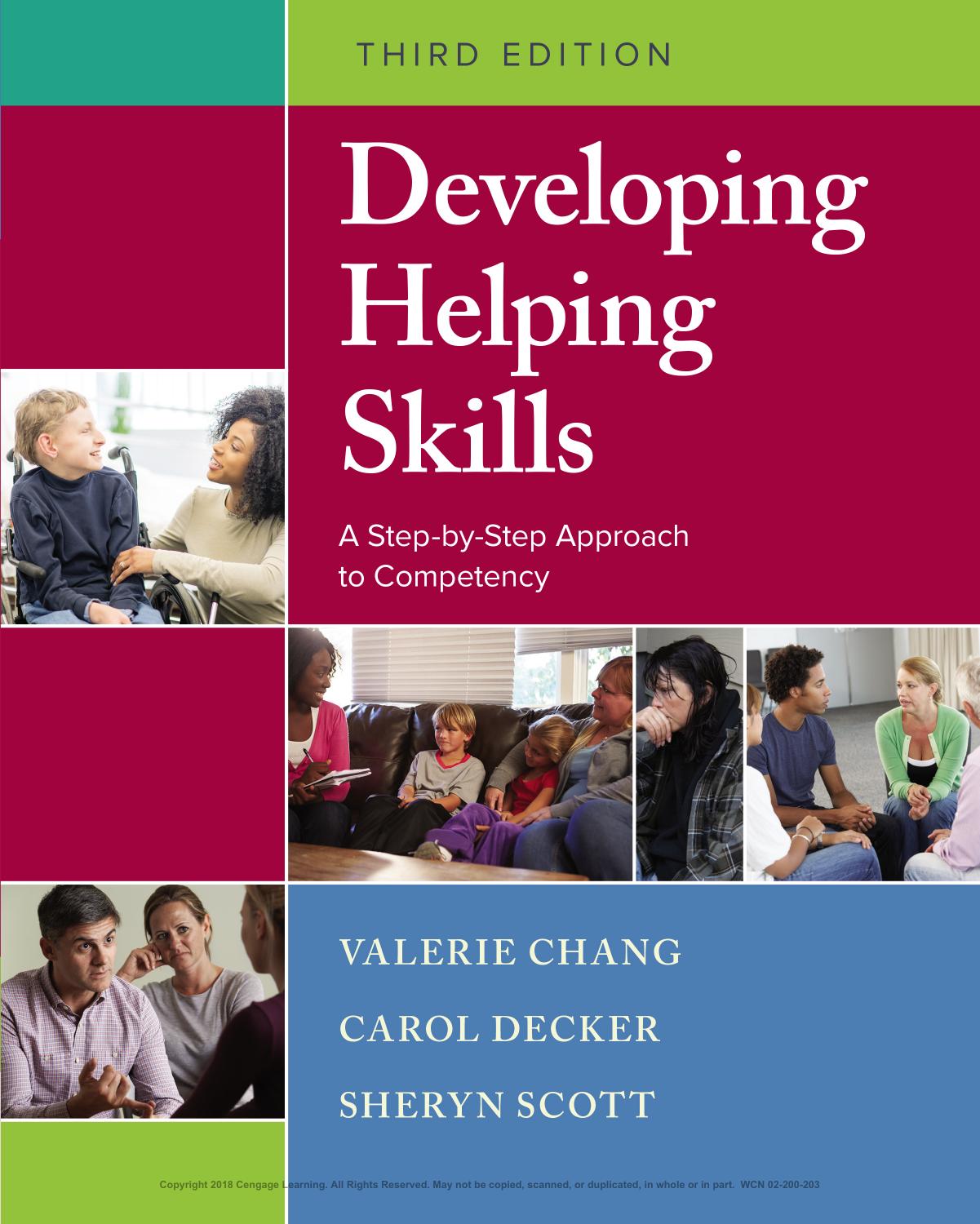Developing Helping Skills A Step by Step Approach to Competency 3rd Edition by Valerie Nash Chang, Carol Decker, Sheryn Scott 9781305943261 1305943260
$70.00 Original price was: $70.00.$35.00Current price is: $35.00.
Instant download Developing Helping Skills A Step by Step Approach to Competency 3nd Edition after payment
Developing Helping Skills A Step by Step Approach to Competency 3rd Edition by Valerie Nash Chang, Carol Decker, Sheryn Scott – Ebook PDF Instant Download/Delivery: 9781305943261, 1305943260
Full dowload Developing Helping Skills A Step by Step Approach to Competency 3rd Edition after payment

Product details:
• ISBN 10:1305943260
• ISBN 13:9781305943261
• Author:Valerie Nash Chang, Carol Decker, Sheryn Scot
Developing Helping Skills: A Step-by-Step Approach to Competency
Developing Helping Skills A Step by Step Approach to Competency 3rd Table of contents:
Section 1. Foundation
Chapter 1. Understanding Yourself and Others
Influences on Personal Development
Influence of Culture, Race, and Ethnicity
Culture’s Influence on the Practitioner
Culture’s Influence on Clients
Influences of the Dominant Culture
Influence of Gender
Influence of Sexual Orientation
Influence of Socioeconomic Status
Influence of Spirituality and Religion
Influence of Life Stages
Influence of Family of Origin
Influence of Disability and Ability
Influence of Stress and Demands
Influence of Your View of Self and Others
Summary
Chapter 2. Ways of Understanding and Perceiving Self and Others
The Constructivist Perspective
Defining the Constructivist Perspective
Personal and Social Constructs
Applying the Constructivist Perspective
Family Systems
Applying the Family Systems Perspective
The Ecological Perspective
Defining the Ecological Perspective
Ecological Perspective Concepts
Applying the Ecological Perspective
The Strengths Perspective
Defining the Strengths Perspective
Applying the Strengths Perspective
The Resilience Perspective
Applying the Resilience Perspective
The Empowerment Perspective
Defining the Empowerment Perspective
Applying the Empowerment Perspective
The Dual Perspective
Defining the Dual Perspective
Applying the Dual Perspective
Summary
Chapter 3. Values, Ethics, and Legal Obligations
Personal Values
Professional Values
Ethical Standards
Professional Competency and Integrity
Technology and Ethics
Confidentiality
Stigma
Moral Obligation and Modeling
Technology and Confidentiality
Prohibition of Boundary Violations
Personal Relationships That Predate the Professional Relationship
Multiple Relationships during the Professional Relationship
Sexual Relationships
Multiple Relationships Following the End of Professional Relationships
Behaviors with Boundary Implications
Assessment
Informed Consent
Legal Obligations
Ethical Violations and Licensing
Duties to Clients
Legal Limits of Confidentiality
Civil Legal Challenges
Minimizing Risk of Ethical and Legal Challenges
Ethical Decision Making
ETHIC Model of Decision Making
Summary
Chapter 4. Professionalism and Professional Relationships
Acting in a Professional Manner
Professional Roles
Advocating for Change
Developing a Professional Identity
Maintaining Respectful, Productive Relationships with Colleagues
Using Supervision and Consultation
Engaging in Career-Long Learning
Unique Nature of Professional Relationships
Summary
Section 2. Building Professional Relationships
Chapter 5. Developing Working Relationships
Use of Self
Helping Relationships
Core Interpersonal Qualities
Warmth
Empathy
Cultural Diversity and Empathy
Respect
Genuineness
Common Mistakes
Offering Advice
Reassuring
Offering Excuses
Asking Leading Questions
Dominating through Teaching
Labeling
Interrogating
Summary
Chapter 6. Foundational Interpersonal Skills
Core Interpersonal Skills for Helping
Being a Good Observer
Observing in Groups
Observing in Community Groups and Organizations
Attending to Clients
Active Listening
Expressing Warmth
Warmth Evaluation Scale
Using Interpersonal Qualities and Skills in Practice Interviews
Summary
Chapter 7. Beginning and Ending a Meeting
Preparing For Work
Beginning a First Meeting
Setting the Tone
Explaining the Process
Beginning Subsequent Meetings
Explaining Confidentiality
Minors and Confidentiality
Confidentiality in Groups
Administrative Contracts
Ending A Meeting
Examples of Ending Statements
Working With Cases
Summary
Chapter 8. Demonstrating Active Listening
The Importance of Being Empathic
Verbally Expressing Active Listening
Reflecting Content
Reflecting Feelings
Reflecting Feelings in Families and Groups
Reflecting Feelings and Content
Summarizing
Reflecting Meaning
Reflecting Understanding of Diversity Issues
Evaluating Expressions of Empathy
Empathy Evaluation Scale
Summary
Section 3. Exploring and Assessing with Clients
Chapter 9. Using Questions
Using Questions to Explore Further
Open-Ended Questions
Closed-Ended Questions
Using Questions to Gain Deeper Understanding
Seeking Clarification
Client’s Role in Clarification
Allowing Silence
Common Mistakes When Using Questions
Genuineness
Genuineness Evaluation Scale
Summary
Chapter 10. Exploring and Discovering
Important Areas to Learn About
Learning about the Problems or Challenges
Learning about the Situation or Environment
Focusing on Strengths and Positive Factors
Identifying Strengths and Positive Factors
Questions to Learn about Strengths and Positive Factors
Connecting Strengths and Empowerment
Demonstrating Respect
Respect Evaluation Scale
Summary
Chapter 11. Assessing Readiness and Motivation
Stages of Readiness to Change
Precontemplation
Contemplation
Preparation
Action
Maintenance
Relapse/Termination
Assessing Stage of Change
Social Cognitive Theory
Assessing Motivation to Change
Discounting
Other Factors That Influence Motivation to Change
Strengths, Capacity, and Resources
Level of Stress and Demands
Hope
Summary
Section 4. Defining the Focus
Chapter 12. Identifying Key Problems or Challenges
Understanding the Client’s Problems
Dealing with Crisis
Working with Clients in the Pre-Contemplation Stage
Blaming Others for the Problem
Rolling with Resistance
Identifying Discrepancies
Working with Clients in the Contemplation Stage
Expressing Empathy
Advanced Reflecting
Identifying Patterns and Themes
Working with Clients in the Preparation Stage
Partializing
Supporting Self-Efficacy
Problem Identification
Ethical Considerations in Problem Identification
Summary
Chapter 13. Establishing Goals
Identifying General Goals
Identifying Measurable, Attainable, Positive, and Specific Goals
Measurable and Specific Goals
Attainable Goals
Positive Goals
Agreements for Work
Monitoring Alliance with Practitioner and Progress
Monitoring Progress Using Goal Attainment Scaling
Summary
Section 5. Doing, Evaluating, and Ending the Work
Chapter 14. Taking Action
Identifying Steps
Further Exploration of the Problem
Steps Identified by Clients
Using Exception-Finding Questions to Identify Steps
Evaluating, Organizing, and Planning the Steps
Monitoring Progress and Focusing on Improvement
Examples of Focusing on Improvement
Skills to Enhance Achievement of Steps
Teaching
Directing
Inviting a Different Perspective
Identifying Discrepancies
Giving Feedback
Examples of Giving Feedback
Self-Disclosure
Immediacy
Summary
Chapter 15. Evaluating and Ending Professional Relationships
Evaluating Progress
Evaluation as an Ongoing Process
Evaluation for Professional Development
Ending Professional Relationships
The Ending Process
Feelings about Ending
Endings with Task Groups and Larger Groups
Planning for Career-Long Professional Development
Staying Current on Evidence-Based Practice
Summary
Appendix A. Practice Evaluation Scales
Appendix B. Overall Practice Evaluation Form
References
People also search for Developing Helping Skills A Step by Step Approach to Competency 3rd:
developing helping skills
developing helping skills a step-by-step approach to competency pdf
developing helping skills pdf
developing helping skills a step-by-step approach
developing helping skills a step-by-step approach to competency free pdf


